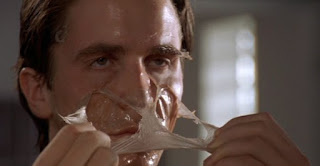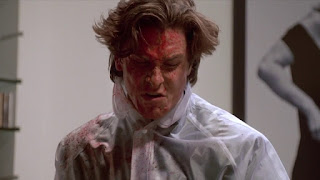To better understand Bateman’s struggle and the argument of the film both the ideal man of hegemonic masculinity and the super-elite of yuppie subculture must be clarified. Hegemonic masculinity is a way of understanding the gendered inequalities and power structures that exist within society. In his article on these hierarchies, Francesco Morettini defines hegemonic masculinity as a glorified form of masculinity used to secure men’s dominant position in society over women and other less socially acceptable forms of masculinity. When this type of masculinity is performed men must constantly compare themselves to it creating hierarchies where they must place themselves (Morettini). Men must behave in certain ways around one another in order to maintain their place within the hierarchy of masculinity. In her article analyzing male interactions, expert Sharon Bird writes, “Three of the shared meanings that are perpetuated via male homosociality are emotional detachment, competition, and the sexual objectification of women (122).” In the past hegemonic masculinity often manifested itself in very violent and aggressive ways. When taken to its extreme, serial killers and rapists could be considered the exemplars of masculinity. As society progresses in the fight for human rights and gender equality hegemonic masculinity has had to make slight compromises in order to sustain power. These compromises were highly visible during the Reagan era in subcultures like hair metal bands, male goths, and yuppies. Each of these groups dipped into the feminine domain either with, feminine clothing and makeup, emotional vulnerability, or in the case of yuppies, excessive consumerism. Yuppie subculture values appearance and the material above all other things. This obsession becomes obvious during Bateman’s opening monologue about his morning routine or the competition between his coworkers over who has the best business card. In these scenes, even the smallest detail is given the utmost importance and all of the characters involved take the situation absolutely serious. These qualities have typically been coded as feminine. There are similarities between the greed-driven yuppie and the “ideal” man defined by hegemonic masculinity. Both identities encourage emotional detachment and ruthlessness in competition, but the vanity of the yuppie decidedly puts it lower in the hierarchy of masculinity. When describing yuppie horror, film scholar Barry Grant writes, “This is hardly surprising, given that yuppie horror films necessarily question (by expressing an unease about) capitalist ideology. Indeed, to the very substantial extent to which yuppie horror films are about masculine panic, (11)” Patrick Bateman’s character is similarly going through a masculine panic. He has started to become disillusioned with the appeal of cutthroat capitalism.
Because the yuppie subculture is
fixated on the surface of things nothing and no one has any real depth.
Characters in the film easily mistake close friends and colleagues for other
people. Those outside of the subculture, like the prostitutes, are beyond
notice and are replaced almost immediately. Even Bateman’s conversations with
friends seem more like sound bites from news articles and reviews than actual
opinions. Everything is surface level and without real meaning. Bateman has
realized how empty all of it is and has attempted to create a new identity. The
only problem is that he is unable to. At the end of the opening monologue, he
states, “There is no real me. I simply am not there.” Instead of showing an
authentic self, he decides to substitute it with another false identity created
from the surrounding media. Slasher horror movies became incredibly popular
during this time and flooded the media market. Throughout the film, Bateman is
seen watching horror movies and violent porn almost ritualistically. He uses
this media to forge his new identity as a mass murderer. His overconsumption of
horror movies also explains his narcissism and sexist ideology. The media that
he watches have male protagonists or characters who are often the force of
change and power. They become the point of identification while the female
figures have no identity of their own. Their level of importance is directly
related to the feelings, often sexual, they can cause in the protagonist and by
association the audience. Feminist cinema theorist, Laura Mulvey expounds on
the lack of female agency in cinema when she writes, “The presence of woman is
an indispensable element of spectacle in normal film, yet her visual presence
tends to work against the development of a storyline, to freeze the flow of
action in moments of erotic contemplation (837).” This serial killer persona
serves a dual purpose. It allows him to secretly rebel against the yuppie
lifestyle he has grown to hate. Martin Rogers reveals the yuppie horror in
“American Psycho” when he says, “The inclusion then of references to the
video-nasties helps to interrupt the dominance of Patrick’s monologue: their presence
indicates an attack on the world from which he comes, and places him in a
particular historical point that can then be exploited as a moment of
resistance/eruption (239).” The crazed, killer disrupts the order and peace
enjoyed by the upper-class. It also gives him the freedom to explore a new
avenue of masculine power that is still privileged in society. Bateman has
retreated to a more traditional form of masculinity, through outright physical
and sexual violence. He is living in a time where women are progressing in
professional careers and gaining more power. Berthold Schoene explains, “This
is definitely the case in American Psycho where existential insecurity and
nervous agitation, caused by a massive epistemological paradigm shift, result
in the lethal death throes of a formerly hegemonic order of gender-specific
subjectivity. Patrick is a dangerous anachronism, the impersonation of an old
order, and, in this respect, his name may in itself be a telling cipher:
Patrick representing “patriarchy.” (381)” His killings could be viewed as a way
to reassert his dominance in a period of female empowerment.
Bateman’s double personality is
what makes the horror in “American Psycho” so unique. Film philosopher Noel
Carrol explains why the monsters in horror are so terrifying when he writes,
“But it is certainly useful for analyzing the monsters of the horror genre. For
they are beings or creatures which specialize in formlessness, incompleteness,
categorical interstitiality and categorical contradictoriness (55).” The fear
Bateman induces doesn’t come from his physical body like most monsters. His
body goes beyond normality into desirability. The horror of Patrick Bateman
exists within his mind. The idea of a physically normal person having two
conflicting personas is frightening. Ruth Helyer writes, “However, the very
acknowledgment that he has apparently succumbed to these urges, not invented
them, makes the unpleasant suggestion that they are lying dormant in all of us,
and the only difference between us and Patrick is that he has indulged them
(727).” The similarities that we share with Bateman are what scare us most, not
the differences.
Bateman’s struggle to balance his
two false identities worsens as the film progresses. The two start to leak into
each other. Before most of his killings, Bateman gives his hollow, yuppie
opinion about a musical artist. He also at random will admit to his homicidal
desires in his social life. He commits more and more killings as he becomes
desperate to discover his real identity but it doesn’t accomplish anything. His
serial killer identity was just as fake and hollow as his yuppie one. None of
his killings were original to him. Bateman repeatedly mentions famous killers,
such as Ted Bundy and Ed Gein. He even mimics Bundy’s cannibalism. The scene
where he attacks Christie feels like a homage to Leatherface. They were all
just attempts at finding some real version of himself that all end in failure.
Bateman captures the meaninglessness of it all in his closing monologue. “My
punishment continues to elude me and I gain no deeper knowledge of myself.” The
two forms of masculinity privileged in society, yuppie and hegemonic, bring
nothing but pain and emptiness to all involved.
Works Cited
Bird, Sharon R. “Welcome To The Mens Club.” Gender &
Society, vol. 10, no. 2, 1996, pp.
120-132.
Carroll, Noel. “The Nature of Horror.” The Journal of
Aesthetics and Art Criticism, vol. 46, no.
1, 1987, p. 51-59.
Grant, Barry Keith. "Rich and strange: The yuppie
horror film." Journal of Film and Video
(1996): 4-16.
Helyer, Ruth. "Parodied to Death: The Postmodern Gothic
of American Psycho." MFS Modern
Fiction Studies, vol. 46 no. 3,
2000, pp. 725-746. Project MUSE
Morettini, Francesco Maria. “Climate Change and Human
Rights.” Global Policy Journal, 27
Oct. 2016, www.globalpolicyjournal.com/blog/27/10/2016/hegemonic-masculinity-how-dominant-man-subjugates-other-men-women-and-society.
Mulvey, Laura. “Visual Pleasure and Narrative Cinema.”
Screen, vol. 16, no. 3, 1975, pp. 6-18.
Rogers, Martin. "Video Nasties and the Monstrous Bodies
of American Psycho." Literature/Film
Quarterly 39.3 (2011): 231.
Schoene, Berthold. "Serial Masculinity: Psychopathology
and Oedipal Violence in Bret Easton
Ellis’s American Psycho." MFS
Modern Fiction Studies, vol. 54 no. 2, 2008, pp. 378-397. Project MUSE






Comments
Post a Comment